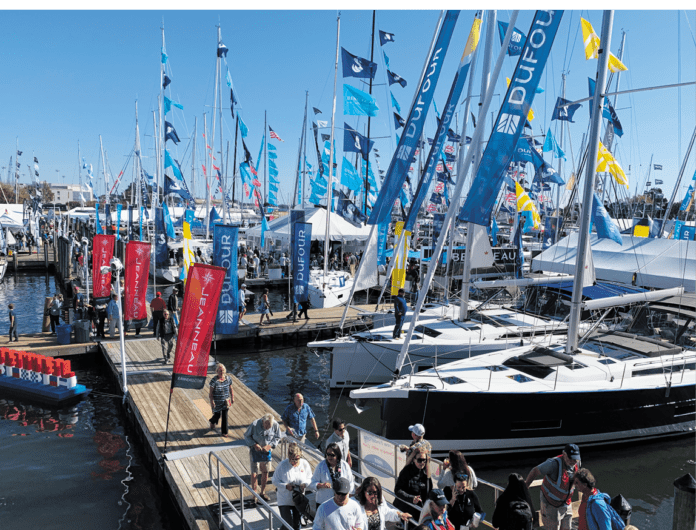I’ve always enjoyed how the annual Annapolis Sailboat Show offers a glimpse of the future—or at least how gear and boat makers envision the future. At the most recent show this October in Annapolis, MD, the trends were hard to miss.
Popularity of sailing. The show management doesn’t publicize attendance figures, but judging from the lines inside and outside the show, sailing is enjoying a healthy rebound after the pandemic. Every vendor I spoke with mentioned the big turnout, and show-goers frequently clogged the docks, especially near the YouTube tent, where celebrity sailors signed hats, shirts, and boat show guides for a steady stream of fans.
Big, wide world. The trend toward multihulls marches on; even monohulls are beginning to look like multihulls. Monos and cats over 50 feet occupied most of dock space for new boats, and multihulls dominated the charter fleet. Several big monohulls like the Hanse 460 featured a retractable awning over an expansive, twin-helm “back porch”—a signature catamaran feature.
Sleek factor. The pursuit of a squeaky-clean deck devoid of any hardware—even cleats—can lead to some interesting places. On the Nautor Swan 48, furling lines and turning blocks hid behind a puzzle of removable panels, including a long, u-shaped locker lid that concealed the collapsible dodger.
Small but mighty. Annapolis is primarily a big-boat show, but each year a fleet of small boats manages to make a splash. Aspiring keep-it-simple sailors clustered around the Tartan 245, a smart, entry-level boat, and the Bluewater Cygnet 20, a new Australian candidate for the growing shire of Hobbit-friendly cruisers. Starting at around $2,000 per foot, these boats won’t attract any bargain hunters, but it’s always educational to see how designers pack glamping essentials belowdecks while preserving a sense of proportion above.
Hide the strings. Aboard many of the bigger boats, a novice could easily wonder how the sails furl and set. Sheets and furling lines tunnel aft and invisibly spill into line bins. On several boats with highly loaded halyards, a halyard slider (a double-horned car on a short vertical track) held halyards for furling sails in tension. Voilà, no more long halyard tail—at least until you have to drop the sail. I saw Antal, Ronstan, and Harken halyard sliders on the bigger boats, all of which had two or more furling sails.
It’s electric. I saw more electric cooktops at Annapolis than ever before. In the multihull world, especially, the dream of enjoying the creature comforts of life ashore with little or no reliance on fossil fuels seems tantalizingly close. Arco’s new high-output regulator, Victron Energy’s lithium battery and charging system, and high-efficiency air-conditioning from Mabru were among several new products at the show that aimed to fully electrify off-the-hook living.







































